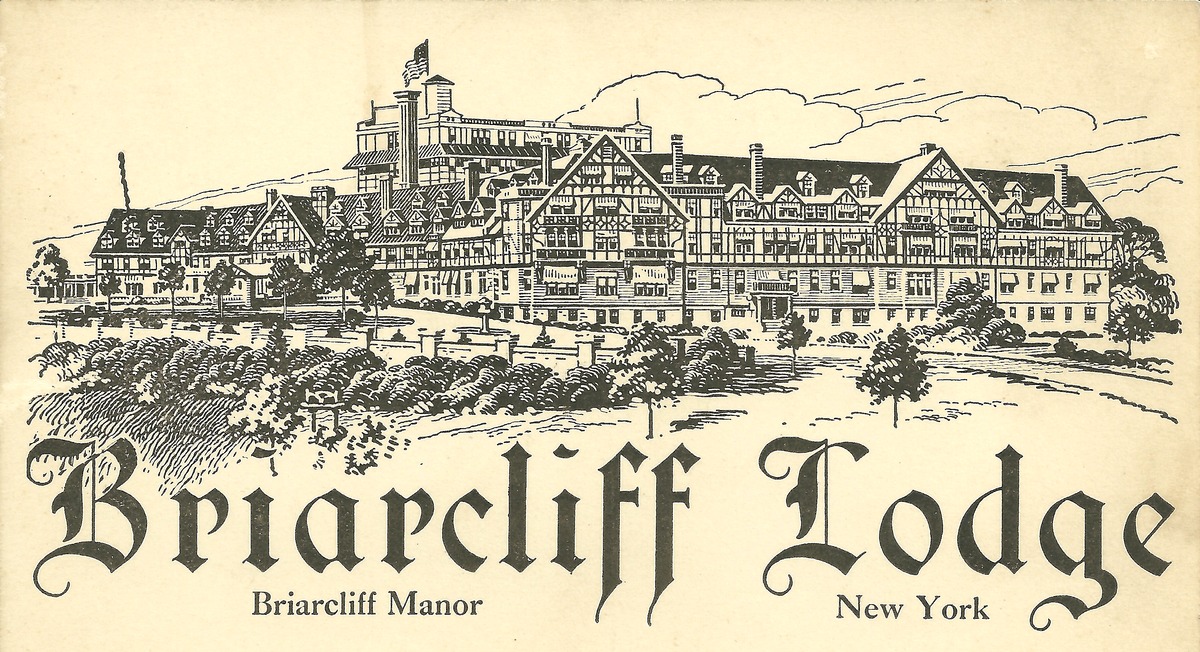Though Briarcliff Manor is a mere 6.7 square miles of New York’s Westchester County, its complex history and extraordinary elegance make it the jewel of New York. What is now know as Briarcliff Manor has been populated by the indigenous, the colonial, the salt of the Earth, the opulent, and the brilliant.
Briarcliff Lodge was at one point one of the largest wooden buildings in the United States and was Westchester County’s first hotel. From a rugged, war-torn stretch of New England riverland to a luxurious destination for New York’s finest, the story Briarcliff Manor is distinctly American.
Before Briarcliff (1609 – 1890)
The Wappinger tribes inhabited the Briarcliff Manor area, then known as Scarborough-on-Hudson. These tribes lived among the Hudson River, and made first contact with Henry Hudson in 1609. Throughout the 17th century, the Wappinger would battle the Dutch colonists, including Kieft’s War in 1643 and the Peach Tree War in 1655.
Frederick Philipse buys Ossining area (1680)
Frederick Philipse, a wealthy Dutch merchant, bought 244 square miles of land from the Wappinger tribes in 1980, from Philipsburg Manor to Spuyten Duyvil Creek along the Hudson River to the Croton. Philipse swore allegiance to the English in the 1690’s and received a title and manorship. He spent the last part of the century building the King’s Bridge at Marble Hill, the Old Dutch Church of Sleepy Hollow, and what would become the Philipse Manor Hall.
The American Revolutionary War and Forfeiture (1765 – 1785)
In 1765, the Wappingers tried to sue the Philipse family for control of the land, but their claim dissolved when the Stockbridge Militia (a Patriot military unit made up of Wappinger, Mahican, and Munsee Native Americans) were killed by the British in the Battle of Kingsbridge during the American Revolutionary War.
The Philipse family lost claim to the land after the war, as English Loyalists. The property was confiscated by the New York State Commission on Forfeiture in 1779 and sold in 1784 and 1785. In the following decades, less than 20 families lived in the 78 square miles of Westchester County, including what is now Briarcliff Manor.
Walter W. Law (1890)
Walter William Law, the wealthy vice president of W. & J. Sloane, bought 236 acres of land in Westchester County, including what would become Briarcliff Manor. He named this stretch of land Briarcliff Farm and dedicated his efforts to scientific farming after his 1899 retirement from W. & J. Sloane.
When Law first came to Westchester County, it was described as a “small, worn-out and unprofitable farm.” What began as a meager 236 acres would expand to 5,200 to become one of the most prosperous farms in New York history.
Briarcliff Farm prospers
Briarcliff Manor started solely as a dairy farm, with meticulous cleanliness, and a gentle approach to cattle farming. The farm was widely acclaimed for the quality of its milk, and soon sold its milk at luxury restaurants and hotels in New York City, and was honored with a gold medal at the Paris Exposition of 1900. Walter Law then opened the School of Practical Agriculture, which taught the fundamentals of farming, with a strict scientific integrity.
Law’s scientific approach to farming led to a prodigious output. At the peak of Briarcliff Farm’s prosperity, the farm produced $100,000 in sales of rose. The farm also raised cows, pigs, chickens, horses, peacocks, pheasants, and sheep.
Briarcliff Lodge is built (1902)
As Briarcliff Farm continued to thrive, Walter William Law built Briarcliff Lodge, the very first hotel in Westchester County.
Law envisioned Briarcliff Lodge “to be placed every convenience, and every device which modern luxury demands. Without it was to be a dream of architectural beauty; within, an illustration of the refined and artistic era in which we live.”
Briarcliff Manor is established
After the Lodge, Law developed the village, schools, churches, and parks. His philanthropic donations provided the land for the Briarcliff Congregational Church and Liberty Park, which would become Walter W. Law Memorial Park. The railroad station was replaced with the Briarcliff Manor Public Library. In 1902, Briarcliff Manor was officially incorporated as a village in New York.
Luxury at Briarcliff Lodge (1902 – 1924)
Westchester’s first hotel was an iconic example of Westchester’s Tudor Revival architecture. Walter Law found comfort in the architecture, as an English immigrant.
Expansion and excellence
Guy King was hired to construct the Briarcliff Lodge as a premiere resort hotel with 93 rooms. The grounds were designed by the Olmsted brothers, sons of the master landscape designer Frederick Law Olmsted. The landscape included a hillside garden, winding walking trails, and flowers grown at Briarcliff Farms.
The number of rooms expanded from 93 to 150 with the addition of the north wing, constructed by John Clark Udall. In 1909, a west wing was built, adding 72-rooms to Briarcliff Lodge.
According to Westchester County historian Rob Yasinsac, “Briarcliff Lodge was in top condition for the thousands of tourists who passed through its doors. By the end of the first decade of the century, Briarcliff Lodge had firmly established itself as the premier resort in the Hudson Valley, if not the country.”
Famous guests and events
Several famous guests stayed at Briarcliff Manor throughout the early 20th century, including Babe Ruth, Thomas Edison, Eleanor Roosevelt, Franklin Delano Roosevelt, the Rockefeller family, Al Smith, Johnny Weissmuller, the king and queen of Siam, and countless others. It was also a venue for numerous events, including The First American International Road Race, along with lavish dinners, dances, variety shows, and a “Fete de Mai” event for a American Red Cross benefit during World War I.
Walter W. Law’s death, prohibition, and decline (1924 – 1955)
In 1923, Briarcliff Lodge was leased to Chauncey Depew Steele as the owner and managing director from 1923 to 1933. Under Steele’s management, the lodge saw a greater diversity of clientele but maintained its status as a destination for the opulent. Devereux Emmet designed a 6,500 yard golf course on the grounds, and the first artificial spa was installed, using radioactive torbernite to alter the water.
The death of Walter W. Law
Walter Law died during a rest cure treatment for health issues in 1924. His funeral was held at the Briarcliff Congregational Church three days later and was buried by his wife, Georgianna Hitt Law, and two of his children.
The hotel declined during the 1930s, largely attributed to prohibition. With the rising popularity of automobiles, guests attended Briarcliff Lodge for shorter amounts of time, and were less likely to stay the whole summer. Steele cut his 20-year lease short in 1933.
The end of Briarcliff Lodge as a hotel
The lodge was used as a “health-diet sanitarium” until it was occupied by the Edgewood Park School for Girls, a nonsectarian Christian preparatory school, which was leased in 1936, and bought a year later. When the school was closed in the summer months, the lodge was used as a hotel, but retained a fraction of its popularity. The lodge ceased operating as a hotel altogether in 1939.
The King’s College and Tara Circle (1955 – 1997)
The King’s College was founded by Percy B. Crawford in 1938 in New Jersey, but relocated to Delaware in 1941, and then to Briarcliff Lodge in 1955, where it was first granted its college charter. Today, many King’s College alumni consider the Briarcliff Manor years the finest years of the college.
The King’s College expands and declines
Enrollment expanded from 300 to 870 between 1955 and 1979 and updated the amenities with electric and heating systems. The college grew its library and constructed a new dormitory in the 1960’s, Walter Law’s original mansion was converted to a men’s dormitory.
The school was closed in 1994, due to financial concerns and a lack of qualified faculty. Upon closure, an Irish-American nonprofit known as Tara Circle attempted to buy King’s College as a cultural center. After years of heated lawsuits between the Briarcliff board of trustees and Tara Circle, they began looking for a new site for a cultural center in 1997.
Briarcliff Lodge vacancy and fire (1998 – 2003)
Briarcliff Lodge fell into disarray and neglect in the years following the Tara Circle dispute. The lodge was unoccupied, and without a guard. Vandalism, break-ins, and theft occurred, and the lodge was slated for demolition in the Autumn of 2003. At that time, repairing Briarcliff Lodge would have cost more than a complete rebuild.
The fire of 2003
Before the Lodge was demolished, the building caught fire. Briarcliff Lodge burnt to the ground, except for the north and west wings, which were made of concrete. Some artifacts were salvaged from the wreckage and sold, but the beautiful wooden architecture was burnt to ash.
A rebirth of luxury (2019)
After years of vacancy after the fire, the historic site of the Briarcliff Lodge is now the home to The Club at Briarcliff Manor, New York’s premier senior living community, offering Independent Living, Assisted Living, and Memory Care services. The glory of Walter W. Law’s vision has been restored and modernized with impeccable detail, from the Tudor-style architecture to the luxurious amenities. Briarcliff Lodge may be a beautiful memory, but the sophistication and splendor live on as an unparalleled retirement community, with elegant tributes to Westchester County’s Golden Age.
For more information about The Club at Briarcliff Manor, and the modern luxuries that await, connect with The Club at Briarcliff Manor today.

